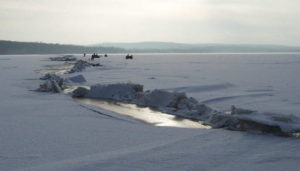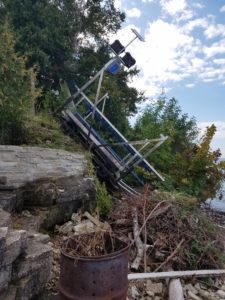What is a Pressure Ridge?
A pressure ridge is the result of a change in temperature which causes the ice to crack and form a floating ice sheet. This formation is usually located a few hundred feet off the shoreline. This is the beginning of a pressure ridge.
The ice near the shore is anchored securely to the shoreline. The floating ice on the outer side of the crack separates and then is moved back to the joint by the winds. The resulting pressure builds up and crushes the edges into pieces called rubble.
The rubble forms the “Keel” of a ridge, which as the name implies, is below the water line. The loose rubble accumulates and builds up until it reaches the bottom of the water. After reaching the bottom the remaining crumbed ice at the surface begins to move vertically. This forms the “Sail” portion or upper part of the pressure ridge. The “sail” is the part you actually see on the surface of the ice. It can be a foot high or several feet high.
The pressure ridge can form very rapidly especially when the wind direction shifts. Since the rubble below is exposed to non-freezing temperatures, it can melt away.. This will leave a very weak and fluctuating joint at the surface.
What is an Ice Shove?
Ice shoves occur during warmer weather also- normally in late February and into March. They require a steady or gusty, strong wind over a period of time.
The ice shove occurs when strong winds rapidly push free floating ice towards the shore. Strong winds from the same direction over, say, a 12 to 24 hour period, are enough to drive huge areas of ice onshore. As these moving masses of ice move towards the shoreline they will begin piling up when they encounter resistance from the shoreline or other obstacles. The resulting ice shove can reach heights of 50 feet.
An ice shove has tremendous power and have been known to push houses off their foundations and uproot large trees. Shoreline barriers like trees, seawalls and shallow cliffs are not a challenge for a ice shove. The ice simply piles up as shown above until it flows over the object or crushes it. It will continue on its journey as long as the wind continues to blow. (See the video at the end of this article for a demonstration of an ice shove)
Ice Shoves can affect a small area of shoreline or vast distances depending on the force of the wind and the strength of the ice. At times, one or two properties are affected while the adjoining properties see no movement at all.
What measures can you take to protect your waterfront equipment?
Simple – In the fall move your docks and lifts far enough back that the ice normally will not get to it. In doubt? Watch what your neighbors do. They know how far back to go.
Here’s an example of what PWS has had to do to prevent damage from ice shoves when there is little or no shoreline:
Boat Lift being removed for winter
This lift and accompanying dock had to be raised to the top of a ledge because there was inadequate shoreline available to protect the equipment from any ice movement.
For more information check this video to see an actual ice shove in action: www.youtube.com/watch?v=Pf5pWz7uRt4
Found this article helpful? Call Jerry at 920-493-4404 or Email Jerry@wisconsinpws.com for more information. Also go to “NEWS” on any page of our website for a complete list of articles meant to keep you informed on the latest product information and maintenance issues.







